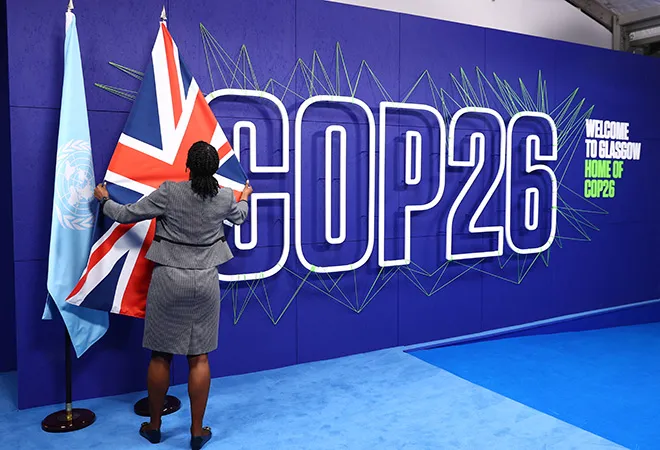 This article is part of the series—Raisina Edit 2021
This article is part of the series—Raisina Edit 2021
There is growing evidence that the coronavirus health crisis and our response to it are making developing countries, and vulnerable people and communities, suffer the most. Children, women, minorities, informal workers and the displaced are the most affected, according to the United Nations and the World Bank. Those fortunate enough to retain their jobs while working from home have consumed images of the extreme precarity faced by vulnerable people all over the world, including those of jobless migrant labourers walking back hundreds of miles in scorching heat to their villages in India. A recent Oxfam report termed the pandemic pathogen, ‘The Inequality Virus”, in that it has affected the rich temporarily but plunged millions globally into poverty. The head of the IMF has spoken of a “Great Divergence”- while rich countries that finance their own debt have spent over 20 percent of GDP to mitigate the impacts of the crisis, middle income and low-income countries have mobilised and 6 percent and 2 percent respectively.
This is not an unfamiliar story. It is the same with climate change. A study by Stanford University in 2019 found that global warming has exacerbated economic inequalities between developed and developing nations since the 1960s, including India. So, COVID-19 and climate change have something in common: they discriminate against the vulnerable. But they also have something else in common: everyone is affected, and only collective action will solve the problem.
Rising inequity, aggravated by climate change and the coronavirus pandemic, provides the stage for the 26th Conference of the Parties (COP26 for short) to be held in Glasgow, this November. As an emerging economy, India represents the economic aspirations of its peers, while simultaneously shouldering greater responsibility for climate action as a world power and one of the top greenhouse gas (GHG) emitters of the world. India is already a leader in green, inclusive and resilient development. Among the top renewable energy installers, India has spearheaded the world’s largest public programme for the adoption of energy efficient lighting while connecting millions to the grid at record speed. The world looks to India, the world’s second most populous country bearing the largest damages due to climate-related extreme weather events, as a champion for action to address not just the causes but also the impacts of climate change at COP26. Under Prime Minister Narendra Modi’s climate leadership, India’s role will be decisive at Glasgow this year.
Near-Term Action and Long-term ‘Net Zero’
In addition to the damages brought about by the COVID-19 pandemic, the year 2020 stood out for successive announcements for stronger action on climate change. China reinvigorated the climate negotiations by announcing a pledge for attaining net zero emissions by 2060, following a peak in emissions before 2030. China was followed soon after by South Korea and Japan with 2050 carbon neutrality goals. The European Union and the UK raised their GHG reduction targets for 2030 to a 68 percent and 55 percent reduction against 1990 levels respectively. With the US back into the Paris Agreement, the pitch for more net-zero emissions targets is getting shriller, and more consistent near-term climate commitments from several countries are now due, including from the Biden administration. “We have to come to Glasgow with no excuses…this is our last best chance to get to net zero,’’ John Kerry, US special presidential envoy for climate said at the World Sustainable Development Summit (WSDS) 2021.
The pressure is now building on all G20 countries, including India, therefore, for both net-zero pledges and more ambitious 2030 action plans, better known as Nationally Determined Contributions (NDC). India’s current NDC has been independently evaluated as a “2°C compatible” fair share of global effort. This is in contrast to China, Japan and South Korea’s NDCs, which fall in the “highly insufficient” range. At a time when countries’ collective efforts have been described as “nowhere close’’ to what is required to fight global warming, building momentum for more carbon-neutral long-term targets backed up with near-term action plans is the only way for guaranteed outcomes. India is ahead of the pack but could do more.
The Make or Break Decade
Adoption of net-zero goals and near-term action plans that are consistent with those goals is more urgent than ever: We need to halve global emissions within this decade in order to put the world on a pathway to avoiding warming above 1.5°C. Warming of 2°C (the pathway for India’s current NDC) is still considered dangerous for many vulnerable populations, which is why vulnerable countries are asking everyone to focus on 1.5°C, not 2°C, as the level of warming to avoid. The 2020s are also the decade of delivery for another universal agreement: The Sustainable Development Goals. Meanwhile, India envisions becoming a $10 trillion economy by 2030.
Building the next generation of infrastructure over the coming decade is inevitable and much required. India will also witness rapid urbanisation resulting in skyrocketing demand for energy, particularly electricity to power urban homes, appliances and lifestyles as well as the energy needed for a range of construction material like cement and steel. A burgeoning urban population would also intensify the challenge of meeting urban transport needs while tackling air pollution, which is already a major killer. The expected business-as-usual emissions rise in India could potentially offset the fall in emissions in Europe by 2040, according to the International Energy Agency.
So, what India does is of interest to the whole world. Building green and resilient infrastructure will be essential to deliver on the socio-economic aspirations of Indian citizens while integrating climate action. The good news is that green and resilient investment provides more jobs and economic multipliers than the less green alternative. According to the World Bank, a climate friendly investment of $1, on average, yields $4 in benefits. A focus on green and resilient infrastructure will help prevent the stranding of assets and minimise the consequences of natural disasters for livelihoods and the well-being of people.
India is expanding a series of mitigation actions, especially in relation to the transition to a clean energy mix. The government has launched a ‘Hydrogen Energy Mission’ in its latest Budget with a focus on generating hydrogen from green power sources. A phased manufacturing plan for solar cells and panels is also in the offing. These add to the country’s pledge of installing 175 gigawatts of clean energy capacity by 2022 and 450 gigawatts by 2030. Renewable energy is now much cheaper than the marginal fuel cost of existing domestic coal-fired power in the country. This story is one that the world needs to hear.
What Must We Agree to at CoP26?
The benefits of investing in climate action are far greater than ever, while the costs of inaction are plain for everyone to see. New economic opportunities and jobs are waiting to be unlocked, especially for developing countries, through climate action. Success in this pivotal year will require not just progress on ambition and commitments but also on the near-term delivery of policies and financing for mitigation and adaptation, with equal emphasis on both. The COP President, Alok Sharma, has identified mitigation, adaptation, finance and collaboration as the four key themes for COP26. So, what does the COP26 agenda mean for India?
On mitigation, long-term targets are often accused of derailing focus from immediate outcomes and, therefore, undermining near-term action. But they can also usher in a virtuous cycle by providing a transparent framework for policy guidance. A clear policy direction, including deadlines for moving away from fossil fuel use, will provide clarity for businesses and investors and, thereby, accelerate adoption of new technologies, like electric vehicles in the near term. Raising ambition often delivers exciting results: India became a world leader in renewable power by revising up pre-existing goals. Net zero targets represent a new starting point, where Indian leadership can help lead the world to a new normal.
On finance, it is clear that weathering the pandemic has exhausted the fiscal buffers of many low- and middle-income economies, while limiting the access of many to private capital markets, preventing green and resilient investment. Donors and international institutions must make cheap credit available to developing economies now to aid recovery. The G7 and G20 are considering the issuance and re-allocation of IMF Special Drawing Rights and the recapitalisation of the Multilateral development banks (MDBs), which is welcome but is only the beginning of what is necessary. The goal for the next five years, starting in 2021, should be to surpass the $100 billion annual commitment by donors on climate finance and combine international public finance with an enabling environment that will leverage private capital at scale. Massively scaled-up access to SDG-linked blended financial solutions, from grants for project development to concessional finance for infrastructure, would be a game-changer for enabling green growth in emerging economies. This capital is needed to retire dirty assets quickly as well as to finance new green assets in developing countries. India can be an advocate for and an exemplar of scaled-up public and private financing, and support at political level a multi-year roadmap on sustainable finance for the G20, culminating in India’s presidency two years hence.
On adaptation, resilience, and loss and damage, climate vulnerable countries attending the UK’s Climate and Development Ministerial have identified a range of measures that are essential to building trust ahead of COP26. These need to be picked up at the World Bank and IMF Spring Meetings, the G7 and the G20, as well as in the climate negotiations. Unmet promises must be met, as India has already highlighted. India can also develop and disseminate best practices in resilience through its domestic actions and partner with other champions through the newly established and India-led Coalition for Disaster Resilient Infrastructure (CDRI). India is already an emerging leader in regenerative agriculture and efficient cooling, the demand for which will only grow; many countries could benefit from India’s experience in these and other areas.
Finally, Alok Sharma’s call for greater collaboration could have been inspired by India’s agenda. India has championed global action by initiatives such as the International Solar Alliance (ISA) and the previously mentioned CDRI. These present huge opportunities for deeper bilateral, regional, multilateral, South-South and North-South cooperation on climate change and sustainable finance. The demand for ISA’s leadership and engagement around the world will only grow, as more and more countries join the solar revolution and look to India’s example. Moreover, the UK and India’s bilateral collaboration on vaccines and climate is a beacon of hope this year. On climate, the UK and India have jointly established a green-focused fund (Green Growth Equity Fund) and plan to set up a bilateral sustainable finance forum among other measures. Specific, practical collaboration of this nature is a key pillar of delivery.
So, in summary, COP26 needs India. But India can also benefit from playing a fulsome role in Glasgow and the key events in the lead up to it. Indian commitment to climate action is already visible to the international community, but India could double down now and become the world’s prime destination for green finance throughout this crucial decade. Surely that is not an opportunity to be missed.
The views expressed above belong to the author(s). ORF research and analyses now available on Telegram! Click here to access our curated content — blogs, longforms and interviews.



 This article is part of the series—
This article is part of the series— PREV
PREV

